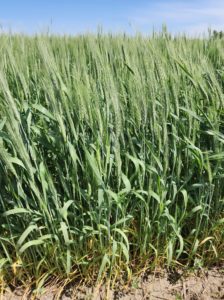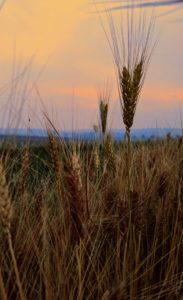A Wealth of Winter Wheat
Wheat is not a crop that is often seen in Iowa. Finding a variety that thrives in the midwestern humidity and fits well into farmers’ rotations can be tricky. But it can also hold a lot of promise for weed control, erosion control and profit. Daniel and Emily Sheetz have been growing wheat on their organic farm near Toledo, Iowa, for a few years now and shared about why they decided to give it a try, what led them to transition from spring to winter wheat, and what they have experienced and learned so far.
A Winding Path to Winter Wheat
Daniel and Emily farm on land that was passed on to them from Emily’s parents. As a farmer, her father, Alan Kouba, was unafraid to branch out from what was perhaps considered normal at the time and experiment with growing things differently. This, along with a desire to produce food-grade quality grain, provided inspiration for Emily and Daniel to choose to transition their approximately 600 acres to organic beginning in 2008. As they settled into their organic practices, they needed to incorporate more crops into their rotations, initially landing on oats as a nurse crop for hay to feed their cow-calf herd and 150 feeder cattle at the time.
After attending a PFI small grains conference, now called Midwest Covers and Grains Conference, and hearing other producers offer insights into growing food-grade oats, Daniel and Emily decided to give food-grade wheat a try. Despite some trepidation due to the disease risk that comes with Iowa’s humid summers, they recognized wheat’s potential for increased profit and ventured out with soft red spring wheat. “We didn’t attempt it in a small way,” Daniel says with a chuckle. “We grew 65 acres and I think it produced about 15 bushels to the acre. It wasn’t good quality and we couldn’t market it easily. It was not something we wanted to repeat.”
A few years later, after learning at another PFI small grains conference to plant earlier maturing soybeans for the purpose of fall-seeding a rye cover crop, Emily and Daniel decided to give winter wheat a try. In early October 2022, Daniel drill-seeded 2-2.5 bu/ac of Wesley Hard Red Winter Wheat at 7.5-inch row spacing after soybean harvest with some expectation that it wouldn’t fare well. It could then just become a cover crop and be tilled under in the spring to make way for another round of soybeans. “But that wasn’t the case!” Daniel says. “We had a little bit of growth in the fall and by spring, we had a really good-looking wheat crop, so we left it. That went about 90 bushels to the acre on approximately 35 acres.”
Observing the Gains
Emily and Daniel’s first season growing winter wheat brought not only improved profit, but also many new insights, giving them more confidence as they begin their second season with the crop. Most notably, they were extremely impressed with winter wheat’s ability to suppress weeds, in contrast to their oat fields that played host to the typical giant ragweed and lamb’s quarter. This weed pressure in the oats has pushed Daniel to choose to swath his oats, so they dry out in the field and can be sifted through the combine. He also swathed his wheat in the summer but feels he can direct-cut the wheat in the future if weed pressure continues to be low.
In terms of both yield and profit, Daniel and Emily have found that their wheat crop fared better than their oats. “The winter wheat maximizes the growing season,” Daniel says. “I probably only had an inch, maybe two at the most of growth on that wheat, but it was enough to go through the winter, and it just took off in the spring much better than my oats did. I put my oats in the last week in March and they really didn’t get started until the first week in April.”
The wheat, which Emily and Daniel ship to Great Lakes Grain and Transportation, LLC, sells at about $14/bu, more than double the $6.50/bu profit they receive from their oats. Wheat straw, which tends to be drier than oat straw, also adds value to the crop, selling this past year at auction for $70/bale and potentially more if sold to a dairy. Despite all this potential with winter wheat, the Sheetz family know that a lot can change with crops from year to year, so don’t plan to transition fully to wheat anytime soon.
On to Another Season
As Daniel and Emily begin their second season with winter wheat, they have drilled in 50 acres of the crop and have learned what they want to do differently this year. In their first season, Daniel used a vertical tillage machine to level the ridges left from row crop cultivation, but he felt it didn’t end up being a big issue and hopes to avoid that extra task ahead of future wheat plantings. He also plans to direct-cut his wheat since it has had little weed pressure and swathing runs the risk of harboring insects or added moisture from unexpected rain.
Though Daniel was encouraged by the low number of weeds in his first season growing winter wheat, he plans to use an Einbach 12-row Aerostar tine weeder to take out the weeds growing in the top half inch of soil. “I hope to see just a little less weed pressure as the crop matures, begins to die back, and lets the sunlight in. Then I won’t have to do significant tillage just to put in the cover crop.” Daniel appreciates that winter wheat provides a broad window to plant a late-summer cover crop and looks forward to experimenting with some different mixes in the next few years that will retain nutrients and maintain soil health for many harvests to come.

Daniel plans to use an Einbach 12-row Aerostar tine weeder to reduce weed pressure for the young wheat, increasing opportunity for a robust cover crop following wheat harvest.
Additional Resources
Sign up for PFI’s monthly Small Grains News email newsletter to receive program updates, small grains resources and information on upcoming events.
Register for our upcoming small grains shared learning calls via Zoom.
Learn about and apply for our small grains cost-share program.



